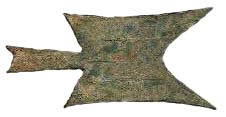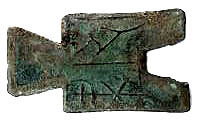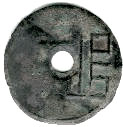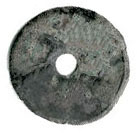|
|
Zhou Empire
(c.1100-255 BCE)
Around 1100 BCE, the rulers from Wei River valley overthrew the Shang dynasty and founded Zhou (Chou) Dynasty. Zhou dynasty lasted for 700 years and produced great works in arts, philosophy and astronomy. The first chinese coins were produced during the Zhou dynasty. By 221 BCE, Zhou dyasty was weakened and Qin (Chin) Kingdom of Wei river valley took control away from Zhou dynasty rulers and started Qin dynasty.
Earliest chinese coins were probably made in Yellow river valley. They were made of in the shape of miniature hoes, spades and knives. They were probably first issued around the 10th century BC during the Zhou dynasty.
Several specimens of hollow handled spades with pointed feet from Shantung peninsula were dated to be from 600 BCE. The dating of these coins is not considered definitive by many scholars. There is considerable disagreement among the numismatic scholars. Hollow handle spades with pointed feet are called Pu. They are considered to be the first coins by some. The name suggest that they might be transition money from primitive money. Pu was the term of earlier primitive money. These spades can not be considered as true coins for lack of stamping or inscriptions on them. However they were cast to an ancient chinese weight standard of 1 liang = 24 shu (1 shu = 0.56g). These spades were cast to 3 liang.

Hollow handled spade
Flat handled spades appeared around 400 BC. They met all the conditions to be a true coin. They have inscriptions of denomination and mint marks. Flat spades were cast to an ancient chinese weight standard based on multiples of 12 shu (1 shu = 0.56g). They were issued in three denominations of 1/2 liang (12 shu), 1 liang (24 shu) and 2 liang (48 shu). They were called "CH'IEN. This word later come to mean money in Chinese language.

Flat handled spade
Thinner flat handled spade coins with a different weight standard appeared around 300 BCE. Denominations were 1/2 liang (10 shu) and 1 liang (20 shu).

Thin flat handled spade
Round coins with round hole in the center appeared around 300 BCE. They have mint mark and monetary units on them. They were cast with new weight standard. There came in two denomination 1/2 liang (10 shu or 5 grams) and 1 liang (20 shu or 10 g) and ch'ien.


Yuan Early Round Coin c.BCE 350
Obverse: Single character Yuan.
Reverse: Blank.
Yuan Early Round Coin c.BCE 350
Obverse: Single character Yuan.
Reverse: Blank.
|
|
Ancient Country List |
|
|
INDEX |
|
Home |
|
|